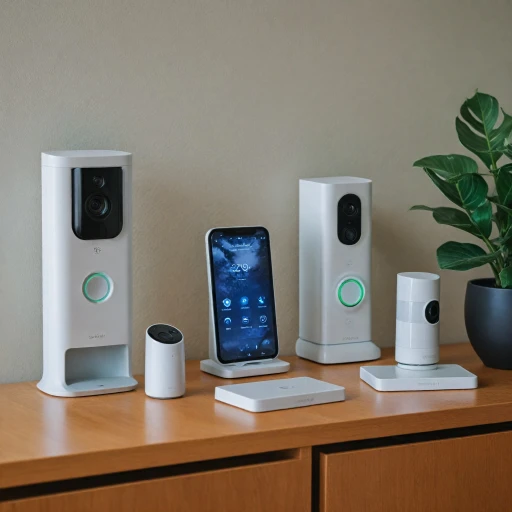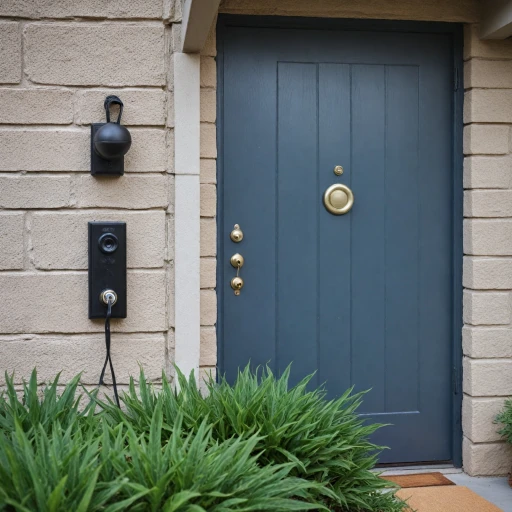
Understanding the Basics of Blink and Ring Doorbells
The Essentials of Blink and Ring Doorbells
When considering video doorbells, both Blink and Ring emerge as prominent options in the current market. Understanding their foundational makeup is crucial for making an informed decision. Let's delve into these devices that promise to elevate home security with ease and efficiency.
Ring, a household name under the Amazon umbrella, has carved its niche with a diverse array of video doorbells and security cameras. These devices are designed to offer comprehensive coverage with impressive video quality, night vision capabilities, and a wide field view. Users can opt for battery powered or wired models, providing flexibility based on individual preferences. An accompanying app allows seamless control and monitoring, ensuring that everything is just a tap away.
Blink, also backed by Amazon, presents a simpler yet potent solution. Known for the ease with which its sync module operates, Blink is recognized for focusing on both indoor and outdoor cam security. While not as feature-rich as Ring in some areas, Blink does provide reliable, essential functions like motion detection and local storage options. This line of security cameras, including the cost-effective Blink Mini and other models, offer customers accessible security solutions.
Both companies continuously update their offers, ensuring their devices remain at the cutting edge of security technology. If you're curious about other similar options, exploring alternatives like the eufy doorbell camera (details here) can further broaden your perspective and help pinpoint the right fit for your home's needs.
Installation and Setup: Ease of Use
Steps to Seamless Setup: Blink vs. Ring
When it comes to setting up your new device, both Blink and Ring aim to make the process as user-friendly as possible. Here's how they compare:- Blink Doorbells: Generally, Blink's installation is straightforward, even for those who aren't tech-savvy. Most Blink models, including the battery-powered options, can be easily installed without any heavy lifting or need for professional help. The Blink Sync Module helps in this simplicity, offering a connection hub to manage your cameras, providing a streamlined setup experience.
- Ring Doorbells: Ring offers a bit more variety in installation options. You can choose between wired or wireless (battery) versions. The wired version might require some assistance if you're not comfortable with electrical wiring, while the battery models are more do-it-yourself friendly. Ring's range of doorbell cameras comes with video guides and thorough instructions in the app, making the setup a breeze for most users.
Configuration Flexibility: Getting the Most from Your Device
Both brands provide detailed tutorials and intuitive apps that guide you through setup and configuration, allowing you to tailor security settings to your preference.- App Support: With both devices, downloading and using the respective apps (Blink Home Monitor for Blink and the Ring app for Ring) ensure you have full control over your security features. These apps are crucial for setting up notifications, motion alerts, and camera views. Ring, being part of the Amazon ecosystem, offers integration with Alexa, adding another layer of convenience.
- Customization Features: Blink offers local storage options through its Sync Module, allowing users to manage footage more independently. On the other hand, Ring offers cloud storage for video clips with a subscription, which can be a key consideration depending on your storage needs.
- Location Versatility: If you're considering placing your video doorbells indoors or outdoors, both Blink and Ring provide models that suit varying environments, whether you need an indoor cam setup or an outdoor-ready solution.
Video Quality and Performance
Quality and Performance of Visuals
When it comes to assessing video quality and performance, both Blink and Ring doorbells offer advanced camera technology to enhance your home's security. However, understanding the nuances can help you decide which doorbell better suits your needs. From a visual standpoint, Ring cameras generally provide high-definition video streams with resolutions ranging from 720p to 1080p, depending on the model you choose. This ensures clear, detailed images day and night. Ring video doorbells often include night vision capabilities, allowing you to monitor your home even in low light conditions. On the other hand, Blink video doorbells also deliver commendable performance, with the Blink Mini and other models offering crisp HD video quality. One major advantage of Blink is its efficient battery-powered design, which makes installation a breeze without needing to connect it to your existing doorbell wiring.Field of View and Motion Detection
A critical aspect of video doorbells is the field view that the cameras offer. Ring cameras are known for having a wide field of view, often measuring up to 160 degrees. This broad perspective provides comprehensive coverage, minimizing blind spots around your entryway. Blink doorbells also offer a wide view, with the added benefit of advanced motion detection technology. With the Blink app, users can customize motion zones, ensuring they only receive alerts for relevant activity. Both Blink and Ring include motion sensor features to ensure you receive real-time alerts on your devices when activity is detected.Video Storage and Accessibility
When considering video storage options, Ring offers cloud storage through a subscription plan. This cloud-based service saves your video clips and events for easy review, allowing you to access footage from your video doorbell at any time. For those interested in long-term storage and enhanced security options, exploring the benefits of a Ring doorbell subscription could be beneficial. Conversely, Blink's local storage option appeals to users seeking an alternative to monthly fees. With the purchase of a Sync Module, owners can save video clips locally, providing flexibility in how they choose to store and access their video footage. This option can be particularly appealing if you're looking to minimize ongoing costs. In summary, both Blink and Ring offer excellent video quality and functionality. Your choice will depend on whether you prioritize field view and motion detection, or if you place greater importance on storage options and potential subscription benefits.Smart Features and Integration
Exploring Innovative Smart Features and Integration
When choosing between Blink and Ring video doorbells, understanding smart features and integration options is crucial. Both brands offer a variety of features although there's a clear distinction in their offerings, enhancing their security devices' overall user experience. For starters, Ring is well-known for its smart integrations. It’s a part of the Amazon ecosystem, allowing for seamless interaction with Alexa-enabled devices. This feature permits you to receive live footage of your doorbell camera directly from your Echo Show or Fire TV. Ring wireless options ensure flexibility, ranging from the battery powered models to its doorbell wired versions, providing constant power supply. There’s also night vision capability on Ring cameras, ensuring video clarity during nighttime. On the other side, Blink offers a distinct experience. It also integrates with Amazon Alexa, though its smart feature suite is generally more straightforward. The Blink Mini cameras rely heavily on the Sync Module, particularly if you opt for battery powered devices, to ensure smooth video transmission and local storage. The Blink video doorbell also supports the addition of outdoor and indoor cams, broadening security coverage when needed. Additionally, both Blink and Ring cameras offer app-based controls, providing real-time notifications, motion alerts, and the ability to store footage in the cloud as well as on local devices if you prefer. Ring's system has the added advantage of professional monitoring, which might appeal to those looking for comprehensive security. In conclusion, your choice between Blink and Ring may very well depend on how deeply you wish to integrate your doorbell camera with other smart devices in your home and what specific features you deem necessary for optimal security.Pricing and Subscription Plans
Costs to Anticipate with Blink and Ring
When considering a video doorbell, the pricing and subscription plans offered by Blink and Ring are crucial factors to weigh.
First, let's talk about initial purchases. Both brands offer a range of devices from simple models to their more advanced counterparts. Blink is known for more budget-friendly options which make them appealing for those on a tight budget. On the other hand, Ring's offerings can be slightly costlier, yet you get a variety of features like the video doorbell and comprehensive support for smart integrations.
Moving to subscription plans, both Blink and Ring provide users with the option to subscribe to cloud services for additional features. Here’s a quick breakdown:
- Ring: Ring offers diverse subscription plans. For instance, their Basic Plan offers cloud storage for video recordings. The Plus Plan, though pricier, includes video recording, professional monitoring, and extended warranties on devices.
- Blink: Blink’s plans are straightforward. A primary plan covers cloud storage for video recordings from a single camera. Their more comprehensive plan permits storage for unlimited cameras, providing more flexibility for users with multiple security cameras.
Neither Blink nor Ring charges for the basic usage of their apps, but opting for a subscription plan enhances the functionalities of your devices by offering extended video history, cloud storage, and sometimes advanced alerts via their apps.
Finally, if you prefer to avoid subscription fees, Blink’s devices offer an alternative with local storage capabilities using a sync module. While this doesn’t provide the same level of security as cloud backups, it’s an option worth considering for those wanting to bypass monthly fees.
Ultimately, the decision between Blink and Ring hinges on balancing features against costs, and determining how much value you place on additional options like cloud storage and advanced monitoring capabilities.
User Reviews and Feedback
User Experiences and Community Feedback
When deciding between Blink and Ring doorbells, user reviews and feedback offer valuable insights into real-world performance and satisfaction. Both brands have their loyal followers, but there are distinct differences that users highlight.
- Ring Doorbells: Many users appreciate the robust security features of Ring doorbells, including its motion detection and night vision capabilities. The Ring app is often praised for its user-friendly interface, allowing seamless integration with other Ring cameras and smart devices. However, some users have noted that the subscription plans for cloud storage can be a bit pricey, although they offer extensive video storage options.
- Blink Doorbells: Blink users often highlight the affordability and ease of use of their devices. The battery-powered option is a favorite for those who want a hassle-free installation without dealing with wiring. The Blink app, while not as feature-rich as Ring's, provides essential functionalities that satisfy basic security needs. However, some users mention that the field of view and video quality, while decent, may not match the high-definition clarity offered by Ring.
Overall, both Blink and Ring offer reliable security solutions, but the choice often comes down to personal preferences regarding features, budget, and the importance of integration with other smart home devices. User feedback consistently emphasizes the importance of evaluating these factors before making a decision.












